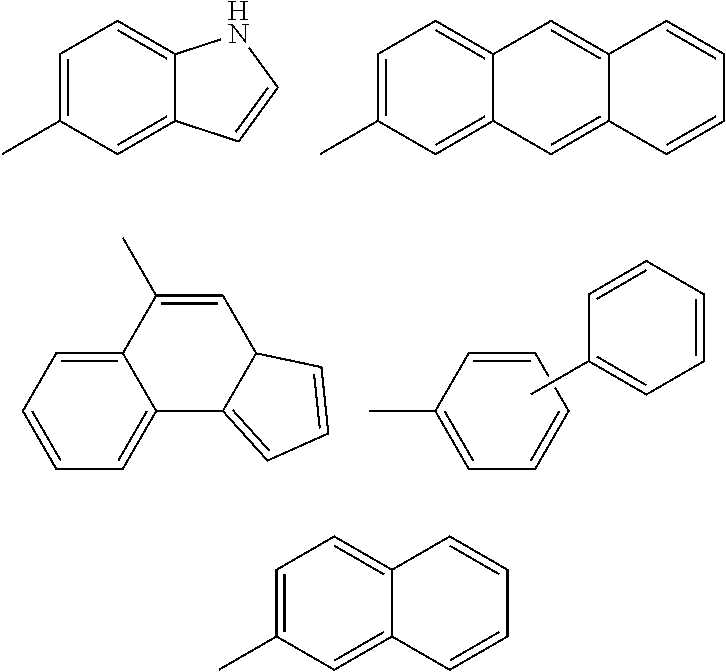Inhibitors of Protein Tyrosine Kinase Activity
a technology of protein tyrosine kinase and inhibitors, which is applied in the direction of plant growth regulators, biocide, animal husbandry, etc., can solve the problems of limiting this approach, affecting the effect of vegf inhibitors as cancer therapeutics, and vision loss, so as to inhibit protein tyrosine kinase activity, inhibit kinase activity, and inhibit tyrosine kinase activity
- Summary
- Abstract
- Description
- Claims
- Application Information
AI Technical Summary
Benefits of technology
Problems solved by technology
Method used
Image
Examples
examples 12 and 13
1-(4-(2-(5-((4-(2,5,8,11-Tetraoxamidecan-13-ylamino)piperidin-1-yl)methyl)pyridin-2-yl)thieno[3,2-b]pyridin-7-yloxy)-3-fluorophenyl)-3-cyclopropylurea (22) and 1-(4-(2-(5-((4-Ethylaminocarbonyl-(2,5,8,11-tetraoxamidecan-13-ylamino)piperidin-1-yl)methyl)pyridin-2-yl)thieno[3,2-b]pyridin-7-yloxy)-3-fluorophenyl)-3-cyclopropylurea (23)
Step 1. tert-Butyl 1-((6-(7-(4-(3-cyclopropylureido)-2-fluorophenoxy)thieno[3,2-b]pyridin-2-yl)pyridin-3-yl)methyl)piperidin-4-ylcarbamate (20)
[0265]tert-Butyl piperidin-4-ylcarbamate (1.34 g, 6.69 mmol) was added to a solution of aldehyde 1-A (2.0 g, 4.46 mmol) and glacial AcOH (0.250 mL) in NMP (20 mL). The reaction mixture was stirred for 30 min. NaBH(OAc)3 was then added and the reaction mixture was stirred for an additional 2.5 hours. The reaction mixture was then poured into a saturated aqueous NaHCO3 solution. A precipitate was formed which was collected by filtration, washed with water and dried. The crude material was purified by column chromatog...
example 17
1-(4-(2-(1-(2,5,8,11-Tetraoxamidecan-13-yl)-1H-1,2,3-triazol-4-yl)thieno[3,2-b]pyridin-7-yloxy)-3-fluorophenyl)-3-cyclopropylurea (30)
Step 1: 2-(1-(2,5,8,11-tetraoxamidecan-13-yl)-1H-1,2,3-triazol-4-yl)-7-(2-fluoro-4-nitrophenoxy)thieno[3,2-b]pyridine (28)
[0270]To a solution of NaN3 (49.6 mg, 0.764 mmol) in DMSO (10 mL) was added 2,5,8,11-tetraoxamidecan-13-yl methanesulfonate (102 mg, 1.2 eq, 0.764 mmol) and KI (127 mg, 1.2 eq, 0.764 mmol) and the reaction mixture was stirred for 12 hrs at RT. Compound 27 (200 mg, 0.636 mmol, UA 2006 / 0287343 A1) and Cu(OAc)2.H2O (34.7 mg, 0.3 eq, 0.191 mmol) were added and the reaction mixture was allowed to stir at RT overnight. The reaction mixture was diluted with DCM (100 ml) and then water (50 ml) was added. The mixture was stirred for an additional 20 min; the pases were separated, the organic phase was collected, dried over anhydrous Na2SO4, filtered and concentrated to give title compound 28 (348 mg, 100%) as an oil (contaminated with DMSO)...
example 18
1-(4-(2-(1-(2,5,8,11,14-Pentaoxahexadecan-16-yl)-1H-1,2,3-triazol-4-yl)thieno[3,2-b]pyridin-7-yloxy)-3-fluorophenyl)-3-cyclopropylurea (33)
Step 1: 4-(2-Ethynylthieno[3,2-b]pyridin-7-yloxy)-3-fluoroaniline (31)
[0273]To a solution of 27 (120 mg, 0.382 mmol, scheme 6) in EtOH (5 ml) was added SnCl2×2H2O (431 mg, 5 eq, 1.91 mmol) and the reaction mixture was heated to reflux for 30 min (Bellamy, F. D.; Ou, K. Tetrahedron Lett. 1984, 25, 839). The mixture was cooled slightly and poured onto ice. A saturated solution of NaHCO3 and DCM were added and the resultant cloudy mixture was stirred for 15 min. The mixture was then filtered and biphasic filtrate was allowed to separate. The aqueous phase was extracted with additional DCM; the organic phases were combined, dried over anhydrous MgSO4, filtered and concentrated to afford the title compound 31 (102 mg, 94% yield) that was used in the next step with no additional purification. MS (m / z): 285.17 (M+H).
Step 2: 1-Cyclopropyl-3-(4-(2-ethynyl...
PUM
| Property | Measurement | Unit |
|---|---|---|
| enantiomeric excess | aaaaa | aaaaa |
| pH | aaaaa | aaaaa |
| pH | aaaaa | aaaaa |
Abstract
Description
Claims
Application Information
 Login to View More
Login to View More - R&D
- Intellectual Property
- Life Sciences
- Materials
- Tech Scout
- Unparalleled Data Quality
- Higher Quality Content
- 60% Fewer Hallucinations
Browse by: Latest US Patents, China's latest patents, Technical Efficacy Thesaurus, Application Domain, Technology Topic, Popular Technical Reports.
© 2025 PatSnap. All rights reserved.Legal|Privacy policy|Modern Slavery Act Transparency Statement|Sitemap|About US| Contact US: help@patsnap.com



